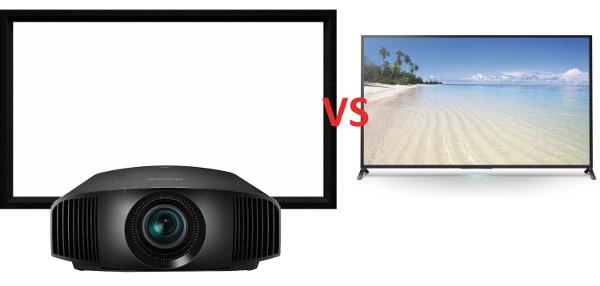The Big Screen Debate: Direct-View TV Vs. Projection

Below are some reasons why one or the other might be right for you.
THE PROS OF VIDEO PROJECTION
No Size Limits. With a projection system, you can project an image as large as your front wall — or viewing distance — supports. Also, unlike a traditional display, the price difference between a 100-, 110-, or 120-inch screen is often only a few hundred dollars.Multiple Aspect Ratios. While 16:9 aspect ratio, direct-view displays are great for watching broadcast sports and sitcoms, many movies are filmed in a wider 2.35 or 2.40 aspect ratio. This means movies will have the “dreaded black bars” and appear significantly smaller. Projection systems can support multiple aspect ratios, either with screen masking that blocks off unused portions of the screen, lens memories that zoom and focus the image for different sizes, or anamorphic lenses. Stewart Filmscreen unveiled its new Gemini Dual-Roller ElectriScreen at CEDIA last September, a system that incorporates two separate screens — one 16:9 and one 2.35:1 — in one housing! [Editor’s Note: Elite Screen’s Osprey offers similar flexibility.]
You Can Do 3D. Whether you love it or hate it, 3D in direct-view displays has pretty much been abandoned by every major display manufacturer. However, many projector manufacturers have continued incorporating 3D into new models, including Sony’s new sub-$5,000 4K projector, the VPL-VW285ES. If you have a collection of 3D films you want to enjoy, then a projector will be your best — and possibly only — means of doing that.
You Can Conceal It. Even though it offers larger screen options, it can be easier to conceal a projection system than a traditional display. A motorized screen can completely disappear when not in use, rolling up into a housing that hides away in the attic or behind molding. And the projector can be completely concealed inside cabinetry or behind a soffit with just a porthole for the lens to fire through. Another hot trend is ultra-short throw projectors that can be housed out of sight in furniture at the front of the room, while producing 100-inch images!
DIRECT-VIEW TV VS. VIDEO PROJECTION
Direct View Is Less Expensive. You can pick up a direct-view 80-inch UHDTV for less than $2,500 and a 70-incher for under $1,500. That is a lot of screen for not a lot of green. Comparably, a decent projector and screen will set you back a fair bit more. Also, a projector is generally more difficult (i.e., costly) to wire and install. When budget is tight, a flat panel is often the right choice.Brightness Is Not an Issue. Projectors rely on dark rooms to produce the best image quality, and if you don’t have absolute light control in your room, or like to watch with lights on, then a direct-view display is likely the right choice. Sure, there are ambient light rejecting screens like Screen Innovations’ Black Diamond, but these are pricey and still don’t deliver the same picture quality as viewing in a dark room.
High Dynamic Range (HDR) Is Not an Issue. Read any of Tom Norton’s projector reviews, and you’ll see that projectors can’t get anywhere near the 1,000 nits required to deliver the full HDR experience, with most topping out at around 150 nits. This makes HDR on a projection system a far trickier proposition. While projectors can pull off HDR — with the laser-based models looking pretty spectacular — direct-view TVs will likely always be superior in this regard.
Smart Features on Board. Even the best projector is pretty “dumb” by any modern TV standard. No apps, no streaming, no Alexa — heck, not even any speakers! A projector may be the prima donna of the system, but it relies on a whole supporting cast of gear to work. If the goal is simplicity in design, with few (or no) other components, then it’s flat-panel TV all the way.
Whichever display technology works for you, make sure you pair it with an equally impressive audio system for the full movie experience!
























































